Quality of dental restorations. FDI Commission Pro... - ResearchGate
Quality of dental restorations. FDI Commission Pro... - ResearchGate
Quality of dental restorations. FDI Commission Pro... - ResearchGate
Create successful ePaper yourself
Turn your PDF publications into a flip-book with our unique Google optimized e-Paper software.
129recommended that non-gamma-2amalgams should be used.Cavity designStratis and Bryant 111 carried out atwo-year study <strong>of</strong> 111 Class I andII amalgam <strong>restorations</strong> placed byone operator, and reported that acombination <strong>of</strong> modification <strong>of</strong> theocclusal cavo-surface angle andfinishing <strong>of</strong> the restoration had aninfluence on the marginal fractureat two years.Kreulen et al. 112 reported a photographicevaluation <strong>of</strong> the margins<strong>of</strong> 245 Class II amalgam <strong>restorations</strong>placed by three dentists. Theprinciple variable influencingmarginal adaptation was the dentist.In addition, improvement <strong>of</strong> themarginal adaptation by an occlusalbevel was discussed compared withnon-bevelled margins.Investigations published before1992 on the possible relationshipbetween marginal fracture andClass I and Class II cavity preparationsfor amalgam has beenreported in a previous paper, andwill not be discussed further 113 .Fukushima et al. 114 reported astudy on the early marginal breakdown<strong>of</strong> 432 posterior compositeresin <strong>restorations</strong>. It was determinedthat smaller cavities, greaterbulk <strong>of</strong> material at the margin(especially in functional cusp areas),and well-finished margins withoutoverfilling seem to reduce theoccurrence <strong>of</strong> marginal fracture.Material handling and proceduresSuccessful bonding is associatedwith several technique-relatedfactors. The use <strong>of</strong> adhesives istechnique sensitive because <strong>of</strong>complex multi-step applicationtechniques 38,115 . Careful management<strong>of</strong> the status <strong>of</strong> the collagenmeshwork is important to preventit from disintegration or collapseand thereby ensuring optimal resinpenetration 116 .A clinical technique, commonlyreferred to as ‘wet bonding’, hasbeen recommended especially foradhesive systems that utilise waterfree,acetone-containing primers.However, recent research hasrevealed that bonding systems thatutilise water-based primers appearto bond with equal effectiveness todry and wet dentine 117 . Adhesivesystems using acetone-based primersrevealed a higher techniquesensitivity 118 , whereas adhesivesystems containing water-basedprimers appear to be less techniquesensitive,as far as the remainingwetness <strong>of</strong> the acid-etched dentinesurface is concerned 119 .Clinically, the exact timing <strong>of</strong>the different stages <strong>of</strong> bonding asrecommended by the manufactureris <strong>of</strong>ten very difficult. For example,parts <strong>of</strong> the dentine may beetched for the same amount <strong>of</strong>time as the enamel because theprecise differentiation between thetwo substrates is not always possible.Excessive etching may result indemineralisation depths that aregreater than monomers can effectivelypenetrate 115,119 , and causesevere collapse <strong>of</strong> the collagenmeshwork 119 . The depth <strong>of</strong> demineralisationis dependent on etchingtime and phosphoric acid concentration120 , while the thickness <strong>of</strong> themonomer penetration, or ‘hybrid’,layer is a function <strong>of</strong> conditioningtime 121 . However, the implications<strong>of</strong> these variables on long-termclinical outcomes remain uncertain.IsolationDesiccation <strong>of</strong> the demineraliseddentine causes collapse <strong>of</strong> thecollagen meshwork, which impedesthe proper infiltration <strong>of</strong> theprimer 121 . Therefore, a wet bondingtechnique is recommended 122,123 .However, there is a wide range <strong>of</strong>interpretations <strong>of</strong> ‘wet’ 124,125 , withno clear guidelines in manufacturers’directions for use. While thenegative consequences <strong>of</strong> excessiveair-drying are well documented foracetone-based systems 122,123 , theresults for water-based systems arevariable 125 .Contamination <strong>of</strong> the etchedenamel surface with saliva prior tothe placement <strong>of</strong> a resin-basedmaterial significantly reduces thebond strength to enamel. Studieson the influence <strong>of</strong> saliva contaminationon dentine bonding arevariable. Although the tolerance <strong>of</strong>modern adhesives to saliva contaminationhas improved, reductionsin bond strengths may be anticipatedafter saliva contamination. Itis therefore important to preventsaliva contamination after application<strong>of</strong> the primer 126 .The effect <strong>of</strong> using rubber damremains uncertain. In an experimentalstudy comparing shear bondstrength <strong>of</strong> 36 composite resin<strong>restorations</strong> placed either withcotton rolls or under rubber dam,no significant differences werenoted between the two groups 127 .In another study using the sameprotocol, microleakage was assessed.This study concluded that the use<strong>of</strong> rubber dam isolation resulted inless microleakage at the enamelresininterface 128 .Patient factorsIntraoral locationAs for wear, bite force is probablya significant aetiological factorregarding the extent <strong>of</strong> materialdeterioration. As a result <strong>of</strong> relativelyhigh bite forces in the firstmolar region, it can be assumedthat more marginal fractures willoccur in this location.In a study <strong>of</strong> 88 composite resin<strong>restorations</strong> placed by nine <strong>dental</strong>students, it was observed after twoand three years that marginal integritywas significantly better inpremolars compared to that inmolars 100,101 .Berg and Derand 129 reporteddata on 51 out <strong>of</strong> originally 115porcelain inlays made with theCerec technique after five years in46 patients. No significant differencesin marginal ditching weredetected between molars andpremolars.Jokstad 29 did not find any strongrelationship between marginaldegradation and intraoral locationafter five years observation <strong>of</strong> ClassII amalgam <strong>restorations</strong>. Only thelower premolars showed less<strong>FDI</strong> <strong>Commission</strong>, Jokstad et al.: <strong>Quality</strong> <strong>of</strong> <strong>dental</strong> <strong>restorations</strong>




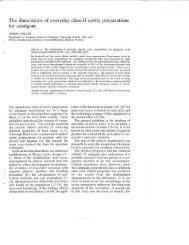
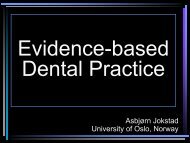
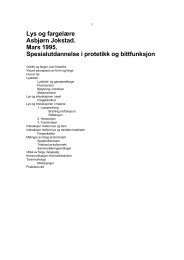

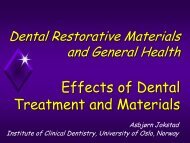
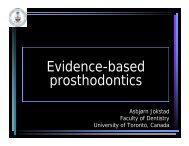

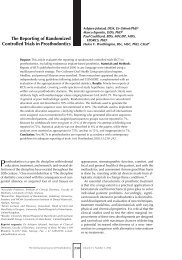
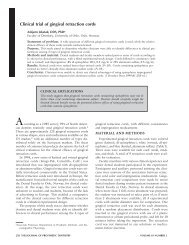

![[Sementer i fast protetikk] Scandinavian Society for Prosthetic](https://img.yumpu.com/18378889/1/190x245/sementer-i-fast-protetikk-scandinavian-society-for-prosthetic.jpg?quality=85)
